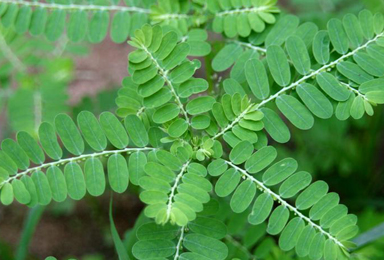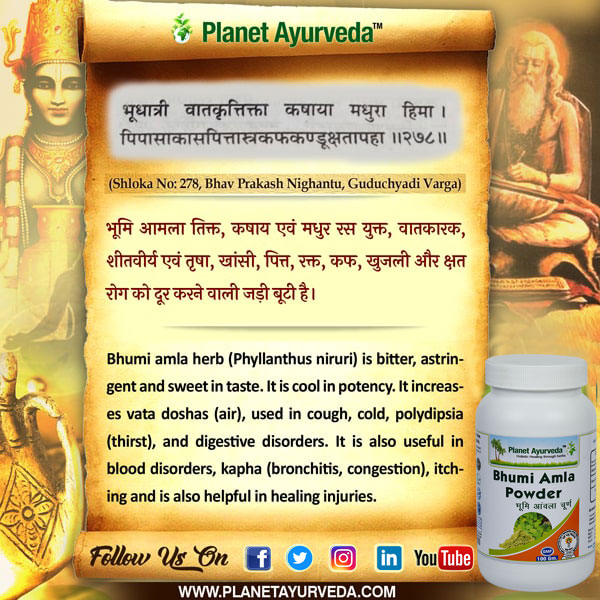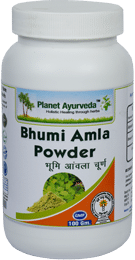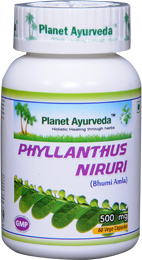Bhumi Amla (Phyllanthus niruri) – Uses & Health Benefits

What is Bhumi Amla?
Bhumi Amla is also known as “Phyllanthus niruri” is a tropical plant that grows 50-70 cm in height. This herb is known as “Bhumi Amla” because it’s a small plant present in Bhumi (land) usually found in rainy season. The bark of this plant is light green in color and smooth. The fruits of Bhumi Amla are tiny, smooth in capsules form containing seeds. The flowers are numerous pale green in color which are often flushed with red color.
Bhumi Amla is commonly known as chanca piedra, stonebreaker, and seed under leaves or gale of the wind. It is also known as bahupatra, tamalaki and uttama etc. This plant is found in temperate climate all over costal India.
Classification of Bhumi Amla
- Kingdom: Plantae
- Family: Phyllanthaceae
- Order: Malpighiales
- Clade: Angiosperms
- Clade: Eudicots
- Clade: Rosids
- Genus: Phyllanthus
- Species: P.niruri
Other Names of Bhumi Amla
- Common name: Phyllanthus, Stonebreaker, gale of wind
- Sanskrit name: Bahupatra, Tamalaki
- Hindi name: Bhumi amla, Jangli amlai
- Marathi: Bhui avla, Bhui amla
- Kannada: Bhu nelli, Nelanelli
- Tamil: Kilanelli
- Telgu: Nela usiraka
- Urdu: Bhumi Amla
- Spanish: Chanca piedra
Medicinal Properties of Bhumi Amla
- Rasa (Taste) – Tikta (Bitter), Kashaya (Astringent), Madhura (Sweet)
- Guna (Qualities) – Laghu (Light for digestion), Ruksha (Dry in nature)
- Veerya (Potency) – Sheeta (Cold)
- Vipaka (After digestion taste conversion) – Madhura (Undergoes sweet taste after digestion)
- Karma (Actions) – Kaphapitta Shamaka (Reduces Kapha & Pitta dosha)
Other Properties of Bhumi Amla
- Antispasmodic
- Astringent
- Anthelmintic
- Appetizer
- Hepatoprotective
- Hypoglycemic
- Hypotensive
- Anti-viral
- Laxative
- Analgesic
- Tonic
- Febrifugal
- Vermifugal
- Emmenagogue
- Diuretic
Health Benefits of Bhumi Amla as per Ayurveda
According to Ayurveda there are many health benefits of Bhumi Amla mentioned below:
- Pandu – The herb is very effective for anemic patients.
- Raktapitta – Bhumi Amla is beneficial in bleeding disorders like heavy periods & nasal bleeding etc.
- Visha – Effective herb in toxic conditions.
- Rochani – Bhumi Amla improves taste and beneficial in anorexia condition.
- Kaphaja Kushta – In all types of skin diseases the herb is beneficial.
- Trushna – Not only in anorexia but also beneficial in excessive thirst condition.
- Shwasa – Effective herb for asthma and chronic respiratory disorders patients.
- Daha – Gives effective results in burning sensation problems.
- Kasa – Bhumi Amla is used in cough and cold problem.
- Hidhma – Helps to get relive from hiccups.
Classical Reference

Indications of Bhumi Amla
- Liver disorders
- Jaundice
- Anemia
- Asthma
- Cough
- All type of Hepatitis viruses like (A, B, C, D & E)
- Malaria
- Kidney stones
- Gall bladder stones
- Diabetes
- Diarrhea
- Dysentery
- Hepatomegaly
- Splenomegaly
- Urinary diseases
- Chronic fever
- Skin ulcers
- Menorrhagia
- Leucorrhea
- Gonorrhoea
- Liver carcinoma
- Veneral disease
- Hypertension
- Cystitis
- Prostastis
- Cataract
- Paralysis
- Facial palsy
- HIV
Bhumi Amla Uses
- The juice of this whole plant is used for various medicinal disorders like loss of appetite, hyperacidity, anorexia, thirst, constipation, diarrhea and dysentery conditions etc.
- The decoction of Bhumi Amla is used for maintaining your liver function tests.
- Chew few leaves of Bhumi Amla on empty stomach it will help to balance your doshas in the body.
- Use of Bhumi Amla powder is effective in various diseases.
- The plant acts as a tonic for an individual.
- Bhumi Amla capsules are also available that contains pure extract of this herb. You can use one capsule once or twice daily.
- Leaves paste of Bhumi Amla are used for treating skin infections.
- For swelling leaves paste are used by mixing small amount of rock salt. Apply this paste at night and clean in morning with lukewarm water.
- Take 15 ml juice of Bhumi Amla for treating splenomegaly, hepatomegaly, fever and various other disorders.
- For indigestion, jaundice, anemia, anorexia and hyperacidity 15-20 ml of Bhumi Amla juice should be taken on empty stomach.
- Fresh leaves decoction is used for treating malaria, typhoid and various type of fever.
- For blocked nose use juice of Bhumi Amla in nasal drop form. Put 2-3 drops in each nostrils.
- Whole plant decoction is used for purification of blood. Take 30 ml of it once daily.
Recommended Dosage
- In juice form take 15-20 ml twice daily.
- In powder form 3 gm to 6 gm as per requirement.
- Capsules: 1-2 capsules twice daily with plain water after meals.
- Decoction: 20-30 ml twice daily.
- You can also chew its leaves on empty stomach.
Planet Ayurveda’s Products which Contain this Herb as an Ingredient
1. Bhumi Amla Powder
Bhumi amla powder is a pure extract of Phyllanthus niruri herb. It is widely used to improve the conditions of the liver, for example, liver cirrhosis. This herb helps to stimulate the digestive fire (Agni), digests the toxins, acts as an appetizer, increases the bile secretion and restores the functions of liver cells. Moreover, the herb has anti-viral, anti-helminthic, hypoglycemic, laxative, and diuretic properties. It controls Vata and Pitta dosha hence manages polydipsia, thirst, cough and cold. This herb shows tremendous results in the diseases such as hepatomegaly, jaundice, hepatitis, liver cirrhosis, nephrotic syndrome, dyslipidemia, inflammatory disorders, auto immune disorders, fatty infiltration of the liver, diabetes, renal ailments, gall stones, etc.
2. Phyllanthus Niruri
Phyllanthus niruri is the product of Planet Ayurveda where pure and standardized extracts of the herb Bhumi amalaki is used. These capsules merely not treat the diseases but also restores the functions of the various organs thus, revives the body. But the potential and the main action of this herb is on the Liver. This capsule helps to rejuvenate the damaged cells of the liver hence beneficial in liver cirrhosis, hepatomegaly, liver fibrosis, and various hepato biliary problems. This is also used to treat kidney problems such as nephrotic syndrome, renal stones, reduced GFR, renal failure, polycystic kidney, etc. It is also used to treat spleen disorders, pancreatic disorders, joint disorder, auto immune disorder, etc. as a supportive herb in pitta disorders it is used to manage hypertension, bacterial infections, malaria, etc.
FAQs on Bhumi Amla
Why Bhumi Amla is known as Bahupatra?
It is known as Bahupatra because the morphology of leaves. There are number of tiny leaves present in this plant. Under its leaves numerous fruits are present in round shape whose appearance is like Amala fruit. These fruits contain seeds in it. When these fruits get open, its seed spreads on the land (Bhumi), which gives rise to new plant.
What are the Chemical Composition of Bhumi Amla?
Bhumi Amla contain bioactive ligans, glycosides, alkaloids, flavonoids, phenyle proponoids, ellagitanis, gernanin, amarin and corilagin present in stem, roots and leaves. In leaves it contains niranthin, nirtetralin phyltetralin. Roots contains Kaemferol-4 rhamnopyranocyte and criodictiol- 7 rhamnopyranoside, lup 20 (29) – en – 3 beta – ol.
Why Bhumi Amla is known as Stonebreaker?
As per the medicinal and chemical properties of this herb it is known as stonebreaker. It crushes down all types of kidneys stones and gall bladder stones naturally without causing any side-effects.
In which type of Liver Disorders Bhumi Amla is Beneficial?
The herb not only treats inflammation of the liver but is also beneficial in five major viral hepatitis. In liver cirrhosis, liver failure, hepatomegaly, jaundice and various other liver disorders it gives effective results.
Is Bhumi Amla gives Effective Results in Splenomegaly?
Yes, the herb not only gives effective results in hepatomegaly but is also effective in splenomegaly. All the properties of this herb helps to maintain a healthy spleen.
What are the Contraindications of Bhumi Amla?
There are no side-effects of this herb but if used in very high dose than it can increases vata dosha in the body. Sometimes its higher dose can also lead to diarrhea and dysentery.






1 thought on “Bhumi Amla / Phyllanthus niruri”